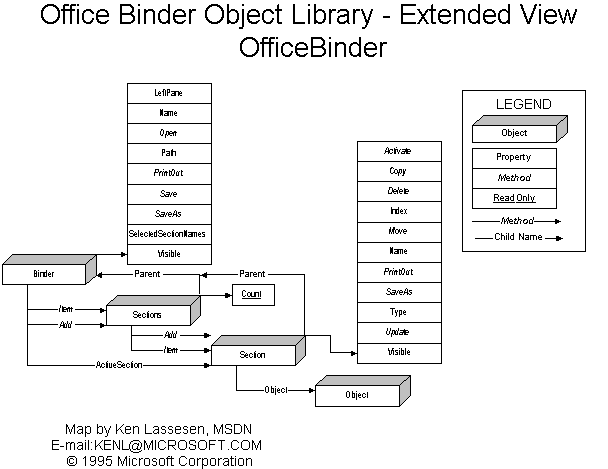
Ken Lassesen
Microsoft Developer Network Technology Group
October 3, 1995
Click here for a diagram of the Office Binder Object (OfficeBinder) in various graphics formats.
This article consists primarily of a graphic map of the Microsoft® Binder Object Library (OfficeBinder) showing its properties, methods, and child object. This object allows different documents to be bound together in a binder. Any Visual Basic®-based language (Access Basic, Visual Basic, and Visual Basic for Applications) and Visual C can access the OfficeBinder object.
The Microsoft® Binder Object Library enables the developer to manipulate the binder, which is a container for multiple documents. The binder is part of Microsoft Office 95.
The Office Binder object (OfficeBinder) is accessible from Visual C and from many Visual Basic for Application–based products. These include Microsoft Excel version 5.0 and higher, Microsoft Access 95, Visual Basic® version 4.0, Microsoft Project, and Visual C++™ version 4.0. For further information on using this object, see the Microsoft Office product documentation and search the Development Library CD. A good starting point is my article "Using Microsoft OLE Automation Servers to Develop Solutions."
Figure 1 (below) shows the relationship between objects as described by the Object Browser built into Visual Basic for Applications and online Help files for Microsoft Office. A map is a good learning aid and a quick reference when developing an application. After producing a map, I found that it was easy to work with the object: I just post the appropriate map on my wall for quick reference, which is a lot faster than clicking objects in a Help file one by one to discover their properties and methods.
I have included the two most common graphics formats—encapsulated PostScript™ (.EPS) and Windows® metafile (.WMF)—as well as a copy of my original Shapeware® Visio™ version 4.0 file (.VSD). The first two formats can be printed across multiple pages using any of the commercial graphics applications—such as Adobe™ PageMaker™, Corel® Draw, or Microsoft Publisher—or using Microsoft Excel. The original Visio file is included for those who have a copy of Visio and wish to modify the diagram easily.

Figure 1. OfficeBinder, the Office Binder Object
The objects and collections in Figure 1 are defined in Table 1. The objects are listed in the same sequence as they appear in the map.
Table 1. Object and Collection Definitions
| Object or Collection | Definition |
| Binder object | This object represents a Microsoft Office binder, a file containing different documents. |
| Sections collection | This collection contains all the sections in the binder. |
| Section object | This object represents a part of a single document and represents a section in a binder. |
Lassesen, Ken. "Using Microsoft OLE Automation Servers to Develop Solutions." (MSDN Library, Technical Articles, Visual Basic Articles)
"Microsoft Office Binder Visual Basic Reference" (VBA_BIN.HLP) is installed with Microsoft Office 95.